Mary Kingswood's Blog, page 16
March 4, 2023
Review: A Fair Judge by Christina Dudley (2022)
 If there’s one word that sums up this book, it’s ‘charm’. This is an absolutely lovely read, a delightful short read that weaves it’s way through the characters and events of the Hapgoods of Bramleigh series with a very deft hand.
If there’s one word that sums up this book, it’s ‘charm’. This is an absolutely lovely read, a delightful short read that weaves it’s way through the characters and events of the Hapgoods of Bramleigh series with a very deft hand.It focuses on Norman DeWitt, brother of Rosemary and Roscoe and second son of Sir Cosmo, a still, silent sort of man who drifts uncomplainingly through his rather ordinary life until he is jolted out of his rut by a chance encounter. A young lady in trouble spurs him to become a rescuing hero, much to his own astonishment, and what a young lady she is! Norman has never been this drawn to a woman before and he’s determined to get to know her better. But there’s a catch, and it’s not one that can readily be solved.
I won’t spoil the surprise by saying any more, but this novella is free to anyone who signs up for the author’s mailing list, so there’s no excuse not to rush off and get hold of it. Five stars.
Review: Reluctant Bride by Joan Smith (2012)
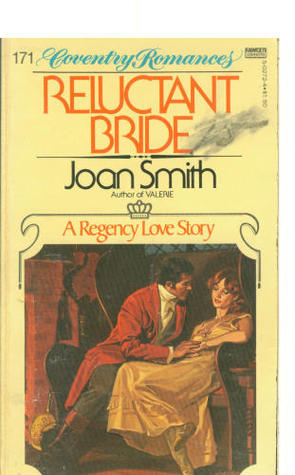 This is not the book for anyone who is a stickler for historical language or plot plausibility. It is, however, wildly funny, and although I rolled my eyes at something or other on every third page, along would come another laugh out loud moment, and so I just kept on reading. It’s outrageously silly, but it doesn’t matter a bit.
This is not the book for anyone who is a stickler for historical language or plot plausibility. It is, however, wildly funny, and although I rolled my eyes at something or other on every third page, along would come another laugh out loud moment, and so I just kept on reading. It’s outrageously silly, but it doesn’t matter a bit.
Here’s the premise (such as it is): Lizzie Bladen and her Aunt Maisie are struggling to keep their heads above water at their impoverished and heavily mortgaged family home, while Lizzie’s younger brother Jeremy is away at Oxford. Lizzie decides she’ll have to sell her dowry, a historic and valuable diamond necklace. On route to her uncle, who has offered to buy it, their carriage is overturned by a fast-driving baronet, Sir Edmund Blount, and in the confusion the necklace is stolen. Lizzie and Edmund are at odds instantly, but he chivalrously decides to help them recover the necklace, and thereby sets in train a glorious sequence of ever more unlikely escapades as they chase around the country in pursuit of a wall-eyed man in a green coat who is the chief suspect.
So far, so promising, but the real fly in the ointment for me was that the book I read immediately before this was another Joan Smith effort, called Love’s Way. And here’s the kicker – its plot is almost identical to this one. The heroine (and her aunt!) are in dire financial straits, thrown together with an antagonistic hero with whom the heroine feuds in melodramatic fashion throughout the book. And although this book at least has some indication that the hero is actually falling for the heroine, she never admits to it, and (just like the previous book) there’s no romantic ending just a shrug and I-suppose-we’d-better-get-married air of resignation. So although I enjoyed the whole thing quite a lot, it was rather spoilt for me by the repetition.
There is one element of the story that I found very funny, but purists might take exception to. Sir Edmund, having been a contented bachelor for a number of years, and having no intention ever to marry, has developed the habit of seeking out female company of a certain type when he’s travelling. He doesn’t stray from the moral code when he’s at home where he’s a respectable figure and wants to keep his reputation, but when he’s away from home he likes a bit of how’s-your-father. This leads to some very funny moments when he’s trying to arrange something, or is actually about to embark upon it, when Lizzie interrupts. Naturally, he gets quite cross about this.
In fact, Edmund’s moods are one of the most entertaining aspects of the book, for they veer about quite dramatically in response to whatever is going forward, and whether he sees it as positive or negative, and although Aunt Maisie soon sees what he’s about, Lizzie never does, and fails to notice that Edmund’s moods are increasingly concerned with her attitude to him.
It’s all great fun, despite being ridiculously implausible, but the sense of deja vu keeps it to four stars for me.
Review: Love’s Way by Joan Smith (1982)
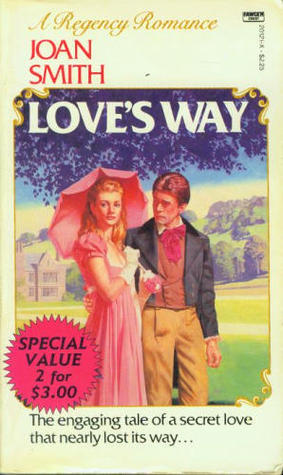 This was a complete riot. It wasn’t perfect by any means, but oh boy, was it funny! The hero and heroine were at odds throughout the book, so they threw everything at each other, verbally, and it was glorious.
This was a complete riot. It wasn’t perfect by any means, but oh boy, was it funny! The hero and heroine were at odds throughout the book, so they threw everything at each other, verbally, and it was glorious.
Here’s the premise: Chloe Barwick is struggling to manage the run-down family estate since her younger brother, Edward, who should be in charge, is obsessed with becoming a poet instead. While he is dreaming up lurid verses and hobnobbing with the Lake District’s resident poets, she’s left to cope with making the sheep raising pay, and trying to scrape together enough money to pay the mortgage every quarter. Aunt Nora, who lives with them, isn’t much help, either. The neighbours, drunken Lord Carnforth and his seemingly innocent daughter Emily are even worse off, living in absolute squalor. So when Emily starts calling on a daily basis and hanging around the interesting Edward, a marriage is out of the question. Edward must marry money to rescue the estate. Chloe herself could rescue them, of course, if only she’d marry Tom Carrick and his five thousand a year. It’s a pity she can’t stand him.
Into this stasis appears the explosive person of Jack Gamble, Lord Carnforth’s nephew, the traditional black sheep, so beloved of Regencies, who’s just returned from India with a fortune in his pocket (another very traditional trope). He immediately sets up Chloe’s back by frightening Emily into running away to Chloe and Edward’s house, from where Jack, in a towering rage, removes her, sets her up with a chaperone and sets about turning her into a pampered rich lady. She seems to enjoy the attention and he seems to be seriously wooing her, and even offers for her, before beginning to discover that behind the barbed tongue, Chloe has a lot of sterling qualities and is far more interesting than ingenue Emily.
This sets up a nice merry-go-round of romances. Will Emily accept Jack’s offer? Will Edward care if she does? Will Chloe see the good in Jack or end up with uninteresting Tom Carrick and his five thousand pounds? The book is a vintage era Regency, so the romance is desperately short on emotion (I don’t think the hero and heroine ever actually come out and say they love each other). Instead, it’s high on the froth of banter and light-heartedly swapping from one potential mate to another, almost as if it doesn’t quite matter. And when they decide that, no, they won’t marry that person after all, it’s a simple matter of saying so. This is not consistent with any Regency code of conduct that I know.
In the background is the villain of the piece, who, in a light-hearted and jovial way, is determined to turn this corner of the Lake District into a vulgar theme park, with every possible tasteless attraction. The Barwick’s house is so run-down that he thinks he’ll just buy it when they inevitably default on the mortgage, knock it down and build a road through it. This part of the story wasn’t so interesting that I wanted to read every last detail of the plans, but it was definitely more interesting than the endless descriptions of the scenery and how to run a sheep farm. All this might have been more convincing without the mention of skunks harassing the sheep and cardinals singing melodically in the beech tree. Nor was I impressed by Edward deciding to organise a fox hunt in the middle of summer (I’m sure the farmers would be thrilled to have the hunt rampaging through their fields and trampling crops and scaring the sheep – save it for the winter months, please).
But you know, none of this mattered tuppence, because the book is *funny*. It’s written in first person for Chloe (‘I went…’ instead of ‘she went…’), and that means the reader is right inside Chloe’s gloriously witty, curmudgeonly and downright cynical head. It’s wonderful stuff, and if I would have liked a little bit less of the theme park villainy and a little more emotion, I can accept that the book is very much of its era, where the characters are slightly cartoonish and not the fully rounded type we expect nowadays. Despite the skunks and cardinals, the sheer enjoyment of the banter makes this a five star read for me.
Review: The Baronet’s Lady Biologist by Alissa Baxter (2022)
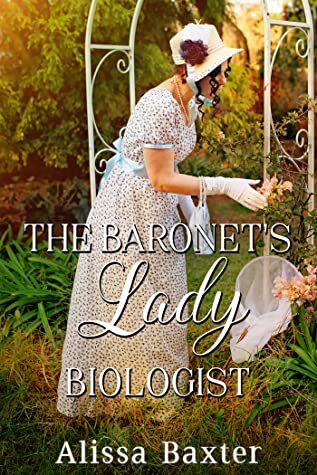 I always look forward to a new Alissa Baxter book. There are very few authors I trust to provide not just a wonderful story but a truly immersive Regency experience, but she’s one of them. This is the third book in the series about the scientific Linfield family, and heroine Georgiana’s interest is in butterflies and insects, and pretty much everything else of a biological nature. There are not many Regency romances where the sentence ‘He had delivered the […] preserved caterpillars to Linfield House’ might appear, but I love a heroine who has her head filled with more than just the latest bonnets.
I always look forward to a new Alissa Baxter book. There are very few authors I trust to provide not just a wonderful story but a truly immersive Regency experience, but she’s one of them. This is the third book in the series about the scientific Linfield family, and heroine Georgiana’s interest is in butterflies and insects, and pretty much everything else of a biological nature. There are not many Regency romances where the sentence ‘He had delivered the […] preserved caterpillars to Linfield House’ might appear, but I love a heroine who has her head filled with more than just the latest bonnets.
Here’s the premise: like her sister Harriet before her, science is the great love of her life, and a husband would only feature if he could be useful to her and finance her travels to collect specimens. Not for her the traditional female domain of home and children. She wants a different sort of husband, one doting enough to indulge every whim of hers. Whoever she marries, it definitely won’t be obnoxious Sir Giles Tavistock, whose arrogance led him to suppose she was setting her cap at him, and to say so where she could overhear him. So not even his handsome face or his own interest in entomology makes him palatable to her.
Georgiana is quite happy to go to London and participate in the season – she might meet that doting potential husband, after all. It takes her away from her beloved butterflies and the countryside, but when she discovers her painting skills are in demand to record the collection of an elderly cousin, and then Sir Giles’s, she’s quite reconciled. Of course, we can see where this is going, and just in case we were in any doubt, there’s an instant attraction between her and Sir Giles. Even though he’s not looking for a wife at all, and she’s looking for a very particular kind of husband, they’re drawn to each other.
Needless to say, there are plenty of obstacles to be swerved around before they realise they’re meant for each other. There are some misunderstandings, but quite believable ones, and not a case of a character simply jumping to an illogical conclusion or taking one person’s word for it. They were also cleared up relatively quickly. There was a rival for Georgiana’s affections, and a nice little subplot involving Napoleon – which was true! And kudos to the author for weaving that little gem into the story in a completely natural way, but then she’s always been brilliant at finding unusual nuggets of research to inspire her writing. A previous book had loads about authentic Regency-era curries, for instance.
Of the characters, Georgiana is a very sympathetic heroine. The modern reader can only feel for her, unable to pursue her chosen scientific research openly, and completely bound by the conventions of the day to the domestic sphere. Her attempts to travel and explore the world are very understandable, but her acceptance of reality is sensible, if a little bit sad. I really wanted her to have her trip to Italy, but Regency women just couldn’t have it all, and social norms (not to mention the lack of contraception) kept them at home. Well done the author for tackling that dilemma honestly.
Sir Giles is my favourite kind of hero, the intelligent but silent type, who may be slow to fall in love, but when he knows his own mind, pursues his goal with steady determination. There were a lot of minor characters, too many for me to keep straight, and I wasn’t totally sure of the purpose of all of them, but they certainly made the story feel realistic. Too many Regencies have the same small group of characters who meet up wherever they go, and London seems to be otherwise empty.
This is a lovely traditional read, which follows the time-honoured path of the London season, balls, house parties and drives with eligible gentlemen in curricles, with the added spice of the scientific background and a nice little mystery going on. My over-sensitive pedantometer wasn’t triggered by any anachronisms (although I had to look up ‘Inuit’, which I wasn’t sure was in use then – but it was!). My only grumbles, such as they are, are that I would have liked a bit more passion from the principals (they were a little too restrained for my taste), and the book felt a little samey. Being the third in the series, and all of them featuring a heroine with a strong interest of her own, a strong, silent scientist hero and a somewhat narrow range of settings, there’s a slight sense of deja vu. But that doesn’t matter because the author’s wonderful writing works its magic to make the book a pleasure to read. A good four stars.
I beta-read this book a long time ago, and received a free copy of the pre-release version, but my opinions are my own.
Review: A Dangerous Nativity by Catherine Warfield (2016)
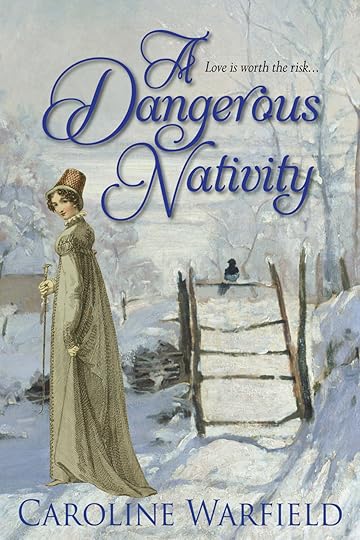 This is a short book that packs in a huge amount of backstory, so much so that it deserved a somewhat more expansive treatment (it almost felt like Reader’s Digest-style condensed novel), but even so, it works pretty well.
This is a short book that packs in a huge amount of backstory, so much so that it deserved a somewhat more expansive treatment (it almost felt like Reader’s Digest-style condensed novel), but even so, it works pretty well.
Here’s the premise: William Landrum, the Earl of Chadbourn has been drawn by the death of his brother-in-law, the Duke of Murnane, to take care of the duke’s affairs. This means the distraught widow, William’s sister, and his nephew, the new duke, since William is the boy’s guardian. There’s also the neglected ducal estate, and he’s heartened to find that a neighbouring estate is in much better and more productive order. Perhaps he can pick up some tips from the owner or manager? But all he finds is Catherine Wheatly, her two lively young brothers and her reclusive father. They’re not particularly friendly, and everyone tells him that the two families never, ever so much as acknowledge each other. Yet they seem ordinary enough, and they share the family name of Wheatly. What is the mystery behind the feud?
Actually, the mystery isn’t terribly difficult to work out, but I did find the feud harder to understand. Again, I think a longer book would have drawn out the nuances of the situation with more depth, because the lingering consequences are quite serious and yet William manages to resolve everything rather easily. In particular, the traumatised widow and the young duke are brought round without too much difficulty. I didn’t find that entirely credible. I also wondered at Catherine’s father being so dogmatic about maintaining the feud. He seems in many ways to be the rational one of the family. And how was it that all these family ‘secrets’ could be so secret after all this time, when the locals would have known exactly what went on? The servants always know.
Nevertheless, despite these quibbles, I enjoyed the read very much. I liked that William knew what he wanted almost from the first moment he saw Catherine (I love a hero who sets his mind on the heroine instantly and won’t be shaken from his path). Catherine was a very down-to-earth lady, and since she knew her own history, her reservations were understandable. Only the shortness of the book, which condensed a lot of interesting story into a format too short for it, keeps this to four stars.
January 21, 2023
Review: Season for the Heart by Elizabeth Chater (1982)
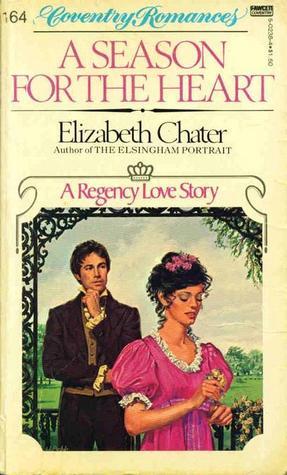 This book was so much fun! It was completely frivolous and silly, and yet there was something about it that just resonated with me. It helped that the hero is my favourite kind – sensible, honourable and witty, just the sort of man a hard-pressed heroine wants to be able to turn to in a crisis.
This book was so much fun! It was completely frivolous and silly, and yet there was something about it that just resonated with me. It helped that the hero is my favourite kind – sensible, honourable and witty, just the sort of man a hard-pressed heroine wants to be able to turn to in a crisis.
Here’s the premise: Miss Melpomene (!) Rand, called Pommy for short, is an orphan. Raised by her classical scholar grandfather, and now living as an unpaid and badly treated servant in her aunt and uncle’s house, she’s sent out in the rain to the local inn to collect a parcel from the incoming mail coach. Sheltering in the inn’s common room, she overhears a plot to hold up her uncle’s carriage the following day and steal the jewels. Running for help, she instead runs straight into the protective arms of a mysterious stranger…
Well, this is a Regency romance, so naturally the stranger will turn out to be a nobleman – the Earl of Austell, in fact, who summarily deals with the would-be highwaymen and sends Pommy straight home to get dry. When he discovers she’s forgotten the parcel she was sent to collect, he delivers it himself, and sees just how badly she is treated by her uncle and his family. Having discovered a mutual love of romantic fiction, he rescues Pommy and sweeps her off to London to be a companion to his widowed sister-in-law, collecting another stray young lady along the way. All this he takes in his stride – I do like a competent hero.
From here on, the plot becomes increasingly convoluted, involving the stray, her father and a discarded suitor of hers, Pommy’s horrid relations and her very un-horrid military uncle, and the earl’s sister-in-law and nephew, culminating in the obligatory kidnapping. Why is it that Regencies of this era always feel compelled to stuff in a kidnapping at the end? Fortunately, this one ends more in farce than anything else – in fact, the second half of the book is delightfully funny, with some genuine laugh-out-loud moments.
As for the romance, it’s obvious that these two are attracted to each other right from the start, and hooray for a hero who knows his own mind and doesn’t waver in the slightest. There’s a lot of muddle between them about what they really feel, with a great deal of miscommunication, and yes, it could all have been sorted out if they’d just sat down and talked to each other, which is usually a big red flag for me. But the whole thing is done in such a whimsical, light-hearted way, almost fairytale-like (and the parallels with Cinderella are obvious), it was easy to just roll with it. There was only one moment when I felt Austell behaved badly, when he first proposes to Pommy, but he makes it seem like such an off-the-cuff thing that she doesn’t take him seriously. A hero should never propose without explaining to the heroine that yes, he does love her, however spontaneous it might seem to be.
One oddity – we never quite know exactly how old the two are supposed to be. His sister-in-law says there’s almost a twenty year age gap, but there’s no particular reason why there needs to be. He says he’s had twelve seasons, so if he was up at Oxford, say, until he was twenty-one, that would make him in his early thirties. Pommy is spoken of as if she’s quite young, but I like to think of her in her early twenties, so the gap would be no more than ten years, and perfectly acceptable.
A couple of historical errors jumped out at me. The sister-in-law (the widow of the earl’s brother) is a duke’s daughter and the brother was a plain Mister, so she would be Lady Aurora Masterson, and definitely not Lady Masterson, as she is called throughout. And then there’s the question of whether Austell would marry his sister-in-law. Since they fall within the church’s proscribed levels of consanguinity, such a marriage would be frowned on. Legally, it’s possible, and two of Jane Austen’s brothers married the sister of their dead wife, but the marriage would be voidable – any challenge would render it void and the children illegitimate, and that’s not something that a peer could contemplate. Another small point – a hitching post is a term not common before 1850. In the country, a groom would be found to hold a horse, and in town street urchins did the job.
The book finishes in fine style, with a couple of satisfying side romances and a properly romantic denouement for the main couple, although like all books of this era, everything ends pretty much straight after the proposal. No schmaltzy epilogues here. Books of this age don’t always wear well, but this was one that I loved from start to finish, with clever dialogue and an excellent style of writing that reminded me of Georgette Heyer. Highly recommended. Five stars.
Review: The Belle of Winchester by Christina Dudley (2022)
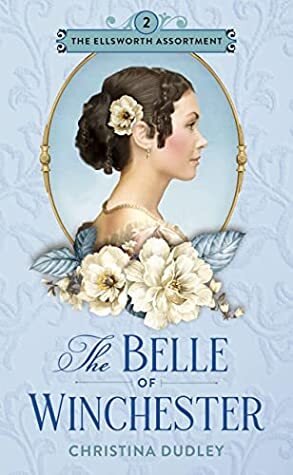 The only thing better than a Christina Dudley book is another Christina Dudley book, and for the first time in my life, I marked the release date of this book in my calendar so I’d remember to download it straight away. I thought Tempted By Folly was superb, but this second book in the series is just as good, lacking only the element of surprise at the endearingly oddball Ellsworth family. With practical Florence safely married off, it’s sparky sister Lily next up, and she’s already decided who she’s going to marry – Mr Gilbert Wright, handsome, rich and dashing. He’s not very bright, but that just means he’ll be easier to manage. But she certainly doesn’t want to tie herself down just yet, because now that Florence is gone and Lily is the Miss Ellsworth and no longer in mourning for their last-but-one stepmother, she’s absolutely ready to have a good time and flirt outrageously and be courted by all the young men of the district.
The only thing better than a Christina Dudley book is another Christina Dudley book, and for the first time in my life, I marked the release date of this book in my calendar so I’d remember to download it straight away. I thought Tempted By Folly was superb, but this second book in the series is just as good, lacking only the element of surprise at the endearingly oddball Ellsworth family. With practical Florence safely married off, it’s sparky sister Lily next up, and she’s already decided who she’s going to marry – Mr Gilbert Wright, handsome, rich and dashing. He’s not very bright, but that just means he’ll be easier to manage. But she certainly doesn’t want to tie herself down just yet, because now that Florence is gone and Lily is the Miss Ellsworth and no longer in mourning for their last-but-one stepmother, she’s absolutely ready to have a good time and flirt outrageously and be courted by all the young men of the district.
Except there’s one who isn’t interested at all. Simon Kenner, the new curate of St Eadburh’s, is as clever as his cousin Gilbert Wright is dim, and sparks immediately fly between him and Lily. For those who like a lot of banter between the romantic leads, this may be right up your alley, because these two are sparring almost from the off. They’re both sharp-tongued, but Simon, at least, is usually more circumspect with his ripostes. He can’t quite understand why Lily Ellsworth somehow brings out the worst in him, horrifying his nice sister, Sophie, and causing him to repeatedly bend his steps towards Hollowgate to apologise to Lily, only to fall into another spat with her. Lily, meanwhile, is very put out to find that the annoying curate is capable of tying her in all sorts of knots, when she’s normally so much in command.
And now you would probably be thinking – I know how this is going to go, but you’d be wrong. This is a Christina Dudley book, which means that nothing happens quite the way you’d expect. I love the way she gradually ties the characters into more and more tangled knots, only to spring them free at the very last moment with a seemingly impossible twist. I’m not going to spoil the surprise by telling you anything more about it, but both Lily and Simon have to make some adjustments and grow up (yes, and suffer a bit!) before they get to their happy ever after.
I liked that the new stepmother is sensible enough to offer some wisdom to Lily, unlike some of Mr Ellsworth’s previous choices, and I was happy to see that nice Sophie is too smart to have her heart broken. It was also fun to have a little glimpse into the clerical world of Winchester Cathedral (with its echoes of Barchester Chronicles). A wonderful, intelligent and very funny read, with the inevitable five stars.
And I absolutely cannot wait to read Minta’s story. Another one to mark on the calendar.
Review: Lovers’ Quarrels by Joan Smith (1975)
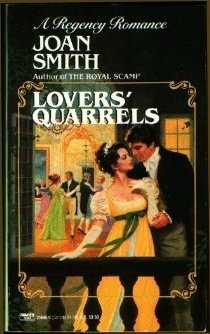 This is one of those rollicking, lighthearted Regency romps that requires the reader to leave absolutely all rational thought in a cupboard somewhere and simply roll with it. Sometimes, if the characters are charming enough I can do that, but there was just too much unlikability here for me to manage it.
This is one of those rollicking, lighthearted Regency romps that requires the reader to leave absolutely all rational thought in a cupboard somewhere and simply roll with it. Sometimes, if the characters are charming enough I can do that, but there was just too much unlikability here for me to manage it.
Here’s the premise: Jane Halsey and sister Belle are living in near destitution with an aunt in an obscure corner of London. The only way to rescue themselves from ever-worsening poverty is for one of them to marry a rich husband, but how can they ever meet a likely candidate, when they know no one and go nowhere? But one day, they have a stroke of luck – they attract the attention of bonkers Lord Romeo, the younger son of a duke, who’s grown up in Greece and become enamoured of all things Greek. He spies Jane and immediately recognises her as Athene, and wants to paint her, naked if possible, and then marry her.
Jane has no interest in Romeo for herself, but he’d suit Belle perfectly, so the sisters fall in with Romeo’s plans. But along with Romeo comes his big brother, the Marquis of Renfrew and heir to the dukedom, who thinks clever, managing Jane is just the wife to keep Romeo under control. He tags along to encourage Romeo’s suit, but ends up attracting the attention of Jane herself, who thinks he’s pursuing her.
Now, this is where I lost patience with our heroine. Jane’s supposed to be a smart cookie, but why on earth does she imagine for one moment that she, the daughter of a mere baronet, currently homeless and virtually dowerless, would be the object of a future duke? She casually calls him Renfrew, as if she’d known him all her life, assuming he’ll dance with her and being thoroughly presumptuous and encroaching and obnoxious. Knowing that Romeo has set his sights on her, she must surely see that his brother can hardly be courting her as well. So I disliked her pretty thoroughly at this point, and cringed every time she made another assumption.
As for Renfrew, even though he suspects that she’s forming an attachment to him, he does nothing about it, and certainly fails to convey to her that his only interest is in fostering Romeo’s suit. He convinces himself he’s mistaken, and carries on quietly falling in love with her himself. And then things get even sillier, and build to one of the most ridiculous finales I’ve ever read.
Now, this wasn’t a bad read, exactly. It’s as well written as Joan Smith’s books always are, and there are certainly moments of laugh-out-loud fun. But the oddball charm of Romeo in Babe palls in its repetition here, where his oblivious straightforwardness turns into something much more devious, the main pairing of Jane and Renfrew entirely lack charm, the humour of comedy sidekick Munch fell flat and the ending was just too unbelievable. Joan Smith is always a bit hit or miss for me, and this one was definitely a miss. Not unreadable, but only three stars. If you like the sound of Romeo, read Babe instead, a much more fun book.
Review: Babe by Joan Smith (1980)
 This was a lot of fun, in a riotously confrontational sort of way. The heroine is spirited in the way of children who only have to be told not to do something but they instantly start working out ways to do it anyway. So there are plenty of scrapes to be wriggled out of, and a hero who veers between being furiously angry with her and actively condoning her wilfulness.
This was a lot of fun, in a riotously confrontational sort of way. The heroine is spirited in the way of children who only have to be told not to do something but they instantly start working out ways to do it anyway. So there are plenty of scrapes to be wriggled out of, and a hero who veers between being furiously angry with her and actively condoning her wilfulness.Here’s the premise: Lady Barbara Manfred (or Babe to her close friends) has been on the town for six years, and has sailed perilously close to the wind in that time. Her reputation is tarnished, but her impeccable bloodline and fortune still make her acceptable to society, if only just. But the relation she’s been living with is too rackety by half, and is about to remarry and bolt for the continent, so it’s time for the more respectable side of the family to take her in hand and save her from ruining her reputation altogether. Lord Clivedon decides he’ll be the one to do it, with the aid of some of his starchy female relations. The first placement is with the strict and religious aunt, and it isn’t long before Babe is kicking against the traces and getting herself into hot water. But it isn’t until the arrival of the gloriously bonkers Lord Romeo that things go really off the rails…
One of the great mantras for authors is: there must be conflict. That’s true, because when there’s too little conflict, the story becomes boring. But too much conflict can be almost as bad. Both Babe and Lord Clivedon are flighty and volatile, and there’s just no knowing how they will react to any given situation. But gradually, as the story progresses, it begins to become clear that Babe wants to spark a reaction in Lord Clivedon, and he, for his part, is perfectly amenable to her high jinks, and even encourages her, when he’s involved. There’s a wonderful scene when they are stranded at a country inn after a carriage malfunction, happily drinking champagne and playing piquet and smoking cigars (yes, even Babe!), and obviously perfectly suited to each other. Naturally, there are plenty more scrapes to be sorted out before they reach their happy ever after, and most of them involve Lord Romeo.
He’s the sort of brilliantly-conceived side character that readers remember long after the main story has sunk into the darker recesses of memory. He’s a duke’s younger son who was prone to illness as a child, so was sent to Greece to live in healthy sunshine. Whilst there, he’s imbibed a lot of classical aesthetics, a taste for ouzo and a wildly self-centred and child-like view of the world that can’t be diverted. He sees in Babe a Greek goddess of old, decides to paint her, and then that he loves her and will marry her. No matter how many times she tells him this isn’t going to happen, he persists in the idea and nothing, absolutely nothing deters him. I’m not going to spoil the surprise by saying any more about that. Suffice to say, there are some wonderfully funny moments in the latter part of the book. I particularly liked Lord Clivedon’s dealings with his long-suffering secretary.
There are a few anachronisms in the book – words like girlfriend, for instance, and week-end, which are very not-Regency. There’s also the issue of guardianship for Babe. Given that she’s twenty-three and therefore of age, she doesn’t even need a guardian, only trustees to manage her fortune until she’s allowed to have control of it (twenty-five, in this case). Even if she had still needed a guardian, only a father can specify one in his will, and the role can’t be transferred or inherited or changed in any way. If the appointed guardian dies or walks away, someone else could apply to the Court of Chancery to be appointed, but in this case, none of that was necessary. However, the whole premise of the book is that Lord Clivedon becomes Babe’s guardian and takes charge of her life, so there’s not much point in quibbling.
Otherwise, the writing is as competent as usual with Joan Smith. This is a light, fairly frivolous story which I enjoyed very much. Only the guardianship issue keeps it to four stars.
January 12, 2023
Review: A Conformable Wife by Alice Chetwynd Ley (1975)
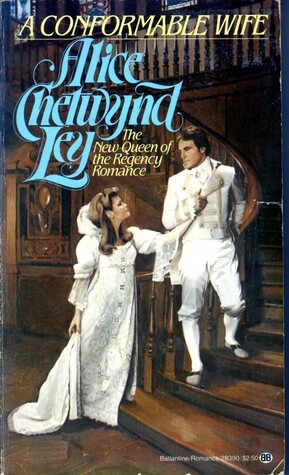 A nice traditional read, and mostly set in Bath, which is always fun. Very redolent of Georgette Heyer, but that’s not at all a bad thing.
A nice traditional read, and mostly set in Bath, which is always fun. Very redolent of Georgette Heyer, but that’s not at all a bad thing.
Here’s the premise: Julian Aldwyn is the heir to an earldom, and after a sudden illness in his father, he’s realised it’s time for him to marry and secure the succession. The trouble is, a disastrous and humiliating love affair before he was even of age has made him wary of women. He wants a restful marriage with the conformable wife of the title, based on compatibility not romantic foolishness. His sister suggests the perfect candidate – Henrietta (Hetty) Melville, very much on the shelf after devoting herself to her family, but very capable. So Julian gets to know her, and although she’s a terrible dowd, he sees enough in her to make her an offer – which she refuses, because she’s still hoping for a love match.
He’s piqued by her refusal, but she’s a bit put out, too, by his unemotional proposal. When an opportunity arises for her to go to Bath to stay with an old friend and have a bit of a girly good time, away she goes, happy to leave the annoying Mr Aldwyn behind. In Bath, she has the makeover so beloved of Regencies, emerging as a beautiful and fashionable woman, and attracting a whole host of admirers. So when Mr Aldwyn finally gets up the gumption to follow her to Bath, to see if maybe he can’t persuade her to change her mind, he finds the dull and dowdy spinster has become a social butterfly, amusing herself with flirtations with her many admirers.
I do dislike the idea that a woman has only to put on a pretty gown and have a new hairdo to become beautiful. Her face and figure haven’t changed, after all, and a plain woman can’t be made less plain by dressing differently, especially not in an era when make-up was little worn. And if a so-called hero *thinks* she’s become beautiful because of some new frocks, he doesn’t deserve her.
I won’t go into the details of all Hetty’s admirers. There were far too many characters in this book, by the time all her friends and relations are taken into account, and most of them were unnecessary and only served to make the book longer and more complicated than it needed to be. There’s a villain, needless to say, with whom Hetty behaves very stupidly and puts herself at obvious risk, and there’s a not-very-challenging mystery to resolve, and a happy ending for one of the minor characters, when an obstacle is rather predictably removed at the last minute.
Some reviews are quite hard on Hetty and Julian, but I rather liked both of them. They both had some baggage to dispose of before they could commit to marriage, she to spread her wings a little after so many years playing the dutiful daughter and sister, and he to realise that not all women are deceitful hussies and that it’s possible to fall in love twice. As for the romance, again, some reviews are negative, saying it comes out of nowhere. Well, it’s not a full-on angsty and over emotional affair, that’s true, but that wasn’t the norm for this era – it’s getting on for fifty years old, after all. But there are clues all the way through that both the protagonists are regretting their initial haste, he to rush to propose without trying to win her over, and she to reject him out of hand. In particular, their behaviour in Bath shows very clearly what’s going on – his obvious jealousy, and her determination to flirt and encourage the most unsuitable men equally suggest more going on beneath the surface. It’s perhaps more subtle than modern audiences are used to, but I liked watching out for these delicate little signs.
The writing is literate and the created Regency world is perfectly believable. It’s one of those books where it’s possible to sink into the story without fear of being jolted back to reality by an infelicitous phrase or a wandering anachronism. I enjoyed it very much, and only the excessive number of characters to keep track of made it sag a little in places. Four stars.



